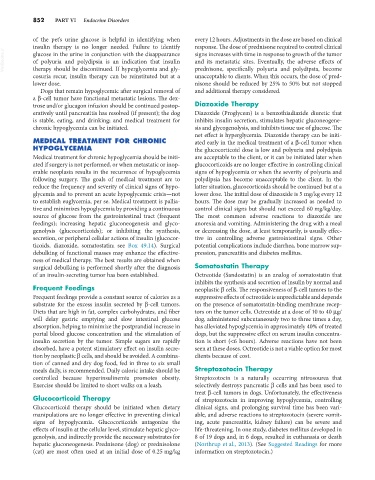Page 880 - Small Animal Internal Medicine, 6th Edition
P. 880
852 PART VI Endocrine Disorders
of the pet’s urine glucose is helpful in identifying when every 12 hours. Adjustments in the dose are based on clinical
insulin therapy is no longer needed. Failure to identify response. The dose of prednisone required to control clinical
VetBooks.ir glucose in the urine in conjunction with the disappearance signs increases with time in response to growth of the tumor
and its metastatic sites. Eventually, the adverse effects of
of polyuria and polydipsia is an indication that insulin
therapy should be discontinued. If hyperglycemia and gly-
unacceptable to clients. When this occurs, the dose of pred-
cosuria recur, insulin therapy can be reinstituted but at a prednisone, specifically polyuria and polydipsia, become
lower dose. nisone should be reduced by 25% to 50% but not stopped
Dogs that remain hypoglycemic after surgical removal of and additional therapy considered.
a β-cell tumor have functional metastatic lesions. The dex-
trose and/or glucagon infusion should be continued postop- Diazoxide Therapy
eratively until pancreatitis has resolved (if present); the dog Diazoxide (Proglycem) is a benzothiadiazide diuretic that
is stable, eating, and drinking; and medical treatment for inhibits insulin secretion, stimulates hepatic gluconeogene-
chronic hypoglycemia can be initiated. sis and glycogenolysis, and inhibits tissue use of glucose. The
net effect is hyperglycemia. Diazoxide therapy can be initi-
MEDICAL TREATMENT FOR CHRONIC ated early in the medical treatment of a β-cell tumor when
HYPOGLYCEMIA the glucocorticoid dose is low and polyuria and polydipsia
Medical treatment for chronic hypoglycemia should be initi- are acceptable to the client, or it can be initiated later when
ated if surgery is not performed, or when metastatic or inop- glucocorticoids are no longer effective in controlling clinical
erable neoplasia results in the recurrence of hypoglycemia signs of hypoglycemia or when the severity of polyuria and
following surgery. The goals of medical treatment are to polydipsia has become unacceptable to the client. In the
reduce the frequency and severity of clinical signs of hypo- latter situation, glucocorticoids should be continued but at a
glycemia and to prevent an acute hypoglycemic crisis—not lower dose. The initial dose of diazoxide is 5 mg/kg every 12
to establish euglycemia, per se. Medical treatment is pallia- hours. The dose may be gradually increased as needed to
tive and minimizes hypoglycemia by providing a continuous control clinical signs but should not exceed 60 mg/kg/day.
source of glucose from the gastrointestinal tract (frequent The most common adverse reactions to diazoxide are
feedings); increasing hepatic gluconeogenesis and glyco- anorexia and vomiting. Administering the drug with a meal
genolysis (glucocorticoids); or inhibiting the synthesis, or decreasing the dose, at least temporarily, is usually effec-
secretion, or peripheral cellular actions of insulin (glucocor- tive in controlling adverse gastrointestinal signs. Other
ticoids, diazoxide, somatostatin; see Box 49.14). Surgical potential complications include diarrhea, bone marrow sup-
debulking of functional masses may enhance the effective- pression, pancreatitis and diabetes mellitus.
ness of medical therapy. The best results are obtained when
surgical debulking is performed shortly after the diagnosis Somatostatin Therapy
of an insulin-secreting tumor has been established. Octreotide (Sandostatin) is an analog of somatostatin that
inhibits the synthesis and secretion of insulin by normal and
Frequent Feedings neoplastic β cells. The responsiveness of β-cell tumors to the
Frequent feedings provide a constant source of calories as a suppressive effects of octreotide is unpredictable and depends
substrate for the excess insulin secreted by β-cell tumors. on the presence of somatostatin-binding membrane recep-
Diets that are high in fat, complex carbohydrates, and fiber tors on the tumor cells. Octreotide at a dose of 10 to 40 µg/
will delay gastric emptying and slow intestinal glucose dog, administered subcutaneously two to three times a day,
absorption, helping to minimize the postprandial increase in has alleviated hypoglycemia in approximately 40% of treated
portal blood glucose concentration and the stimulation of dogs, but the suppressive effect on serum insulin concentra-
insulin secretion by the tumor. Simple sugars are rapidly tion is short (<6 hours). Adverse reactions have not been
absorbed, have a potent stimulatory effect on insulin secre- seen at these doses. Octreotide is not a viable option for most
tion by neoplastic β cells, and should be avoided. A combina- clients because of cost.
tion of canned and dry dog food, fed in three to six small
meals daily, is recommended. Daily caloric intake should be Streptozotocin Therapy
controlled because hyperinsulinemia promotes obesity. Streptozotocin is a naturally occurring nitrosourea that
Exercise should be limited to short walks on a leash. selectively destroys pancreatic β cells and has been used to
treat β-cell tumors in dogs. Unfortunately, the effectiveness
Glucocorticoid Therapy of streptozotocin in improving hypoglycemia, controlling
Glucocorticoid therapy should be initiated when dietary clinical signs, and prolonging survival time has been vari-
manipulations are no longer effective in preventing clinical able, and adverse reactions to streptozotocin (severe vomit-
signs of hypoglycemia. Glucocorticoids antagonize the ing, acute pancreatitis, kidney failure) can be severe and
effects of insulin at the cellular level, stimulate hepatic glyco- life-threatening. In one study, diabetes mellitus developed in
genolysis, and indirectly provide the necessary substrates for 8 of 19 dogs and, in 6 dogs, resulted in euthanasia or death
hepatic gluconeogenesis. Prednisone (dog) or prednisolone (Northrup et al., 2013). (See Suggested Readings for more
(cat) are most often used at an initial dose of 0.25 mg/kg information on streptozotocin.)

